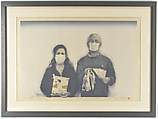March 13th ’20, from the Diary series
Noda Tetsuya 野田哲也 Japanese
Not on view
This print captures the reaction of a contemporary Japanese print artist and his wife to the early stages of the COVID-19 pandemic. The print is titled “March 13, ’20”—which coincidentally is the day The Met shut down for over five months due to the pandemic. As was the case throughout the world, people were advised to wear masks to prevent catching or spreading the highly-contagious virus. According to the artist, on this day, he had received gifts of masks from his next-door neighbor, his sister in Kyushu, and from another friend in Macao. During the complex process of recreating and manipulating the photograph and recreating it as a silkscreen with woodblock printed coloring, he modified the image to include a package of the so-called “Abe masks,” referring to the free masks, two for each household, provided by the government under the direction of then Prime Minister Abe Shinzō. The policy was met with skepticism since two cloth masks, even if washable, would not be adequate to protect a household for any length of time, especially since they were so small, too tightly fitting, and uncomfortable to wear.
Noda is a leading contemporary Japanese printmaker. He has also had a huge influence on an entire generation of contemporary printmakers because of his long-term role as a teacher at Tokyo University of the Arts (Geidai). Several other factors have contributed to his cosmopolitanism and international outlook. He worked in Chicago for several years and, after marrying Dorit Bartur (shown with the artist in this print), daughter of Moshe Bartur, Israeli Ambassador to Japan 1966–1972, he converted to Judaism.
Noda’s works involve a complex interaction of techniques: Western and Japanese; traditional and modern. In this piece, the first stage of the printmaking process began with taking a photograph that he then manipulated using pencil and whiteout. The artist then mimeographed the photograph to create a silkscreen stencil that he printed on handmade Japanese paper. He added another level of modulation by using the traditional Japanese woodblock technique for introducing color and bokashi (gradated color and ink).
This image cannot be enlarged, viewed at full screen, or downloaded.

